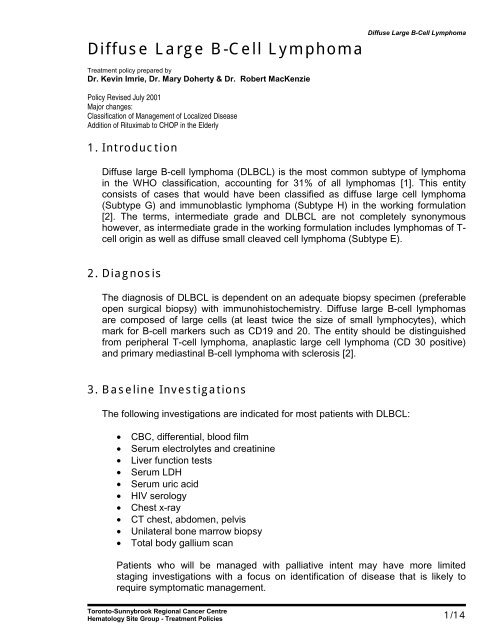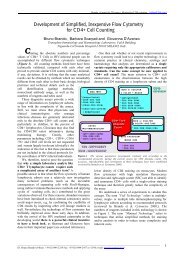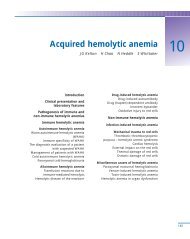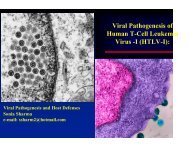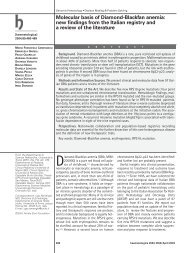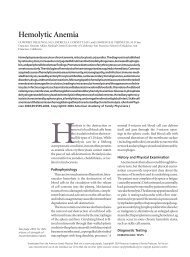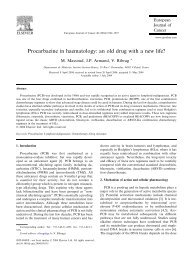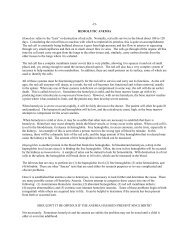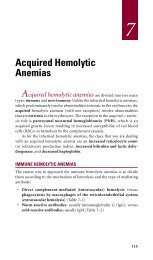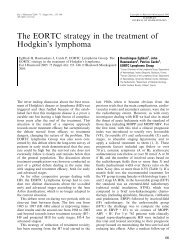Diffuse Large B-Cell Lymphoma
Diffuse Large B-Cell Lymphoma
Diffuse Large B-Cell Lymphoma
You also want an ePaper? Increase the reach of your titles
YUMPU automatically turns print PDFs into web optimized ePapers that Google loves.
<strong>Diffuse</strong> <strong>Large</strong> B-<strong>Cell</strong> <strong>Lymphoma</strong><br />
Treatment policy prepared by<br />
Dr. Kevin Imrie, Dr. Mary Doherty & Dr. Robert MacKenzie<br />
Policy Revised July 2001<br />
Major changes:<br />
Classification of Management of Localized Disease<br />
Addition of Rituximab to CHOP in the Elderly<br />
1. Introduction<br />
<strong>Diffuse</strong> <strong>Large</strong> B-<strong>Cell</strong> <strong>Lymphoma</strong><br />
<strong>Diffuse</strong> large B-cell lymphoma (DLBCL) is the most common subtype of lymphoma<br />
in the WHO classification, accounting for 31% of all lymphomas [1]. This entity<br />
consists of cases that would have been classified as diffuse large cell lymphoma<br />
(Subtype G) and immunoblastic lymphoma (Subtype H) in the working formulation<br />
[2]. The terms, intermediate grade and DLBCL are not completely synonymous<br />
however, as intermediate grade in the working formulation includes lymphomas of T-<br />
cell origin as well as diffuse small cleaved cell lymphoma (Subtype E).<br />
2. Diagnosis<br />
The diagnosis of DLBCL is dependent on an adequate biopsy specimen (preferable<br />
open surgical biopsy) with immunohistochemistry. <strong>Diffuse</strong> large B-cell lymphomas<br />
are composed of large cells (at least twice the size of small lymphocytes), which<br />
mark for B-cell markers such as CD19 and 20. The entity should be distinguished<br />
from peripheral T-cell lymphoma, anaplastic large cell lymphoma (CD 30 positive)<br />
and primary mediastinal B-cell lymphoma with sclerosis [2].<br />
3. Baseline Investigations<br />
The following investigations are indicated for most patients with DLBCL:<br />
• CBC, differential, blood film<br />
• Serum electrolytes and creatinine<br />
• Liver function tests<br />
• Serum LDH<br />
• Serum uric acid<br />
• HIV serology<br />
• Chest x-ray<br />
• CT chest, abdomen, pelvis<br />
• Unilateral bone marrow biopsy<br />
• Total body gallium scan<br />
Patients who will be managed with palliative intent may have more limited<br />
staging investigations with a focus on identification of disease that is likely to<br />
require symptomatic management.<br />
Toronto-Sunnybrook Regional Cancer Centre<br />
Hematology Site Group - Treatment Policies 1/14
CSF Analysis<br />
A lumbar puncture to evaluate leptomeningeal involvement with lymphoma should<br />
be performed in patients with:<br />
• Bone marrow involvement<br />
• Testicular lymphoma<br />
• HIV positivity<br />
• Paraspinal, sinus or vertebral involvement<br />
• Multifocal bone involvement<br />
• Elevated LDH and > 1 extra nodal sites<br />
• Unexplained neurologic symptoms<br />
Samples should be sent for cell count, protein and 5-10cc should be sent for<br />
cytologic examination.<br />
Gallium Scan<br />
A total body gallium scan should be performed in all patients being treated with<br />
curative intent, particularly those who would be considered for salvage therapy and<br />
stem cell transplantation if not in complete remission after initial therapy.<br />
HIV Serology<br />
B-cell lymphoma is the most common malignancy associated with HIV infection. As<br />
HIV lymphoma is treated differently and risk factor assessment is imperfect in<br />
identifying HIV positive patients, most patients with DLBCL should undergo HIV<br />
serology testing at diagnosis. If serology testing is not planned, patients should be<br />
asked in detail regarding risk factors, including blood transfusion, intravenous drug<br />
use and sexual contact with persons who may have been at risk for HIV.<br />
Cardiac Assessment<br />
A cardiac assessment should be performed in all patients potentially eligible for<br />
anthracycline-based chemotherapy (such as CHOP). MUGA scan or 2Dechocardiogram<br />
should be performed in all patients with a history of:<br />
• Age > 60<br />
• Hypertension<br />
• Congestive heart failure<br />
• Peripheral vascular disease<br />
• Cerebrovascular disease<br />
• Angina<br />
• Cardiac arrythmia<br />
• Myocardial infarction<br />
2/14
<strong>Diffuse</strong> <strong>Large</strong> B-<strong>Cell</strong> <strong>Lymphoma</strong><br />
4. Staging<br />
Patients with DLBCL should be staged according to both the Ann Arbor and IPI<br />
staging systems [3].<br />
Ann Arbor Stage<br />
The Ann Arbor staging system continues to be in use in DLBCL. This system<br />
provides limited prognostic information, but is of use in determining patients eligible<br />
for treatment with combined modality therapy. All patients should have an Ann Arbor<br />
stage assigned.<br />
Stage Definition<br />
I<br />
II<br />
III<br />
IV<br />
Involvement of a single lymph node region or a single extranodal<br />
site.<br />
Involvement of two or more lymph nodes on the same side of the<br />
diaphragm or localized involvement of an extra lymphatic organ or<br />
site and one or more lymph nodes on the same side of the<br />
diaphragm.<br />
Involvement of lymph node regions on both sides of the diaphragm<br />
that may also be accompanied by involvement of the spleen or by<br />
localized involvement of an extra lymphatic organ or site or both.<br />
<strong>Diffuse</strong> or disseminated involvement of one or more extra lymphatic<br />
organs or tissues, with or without associated lymph node<br />
involvement.<br />
The absence or presence of fever > 38.5°C, drenching night sweats, and/or<br />
unexplained weight loss of 10 percent or more body weight in the six months<br />
preceding admission are to be denoted in all cases by the suffix A or B respectively.<br />
The International Prognostic Factor Index<br />
The International Prognostic Factor Index (IPI) provides more precise and<br />
reproducible prognostic information than the Ann Arbor stage, but does not<br />
distinguish patients eligible for combined modality therapy for localized disease [4].<br />
The IPI stage is dependent on five prognostic factors: Age, Ann Arbor stage,<br />
Performance status, LDH and number of extranodal sites.<br />
Toronto-Sunnybrook Regional Cancer Centre<br />
Hematology Site Group - Treatment Policies 3/14
Development of a Prognostic Factor Model: The International Index and Age-Adjusted Index<br />
Risk Group<br />
Risk<br />
Factors<br />
Distribution<br />
of cases<br />
CR<br />
Rate (%)<br />
RFS OF CRs (%) Survival (%)<br />
2-yr 5-yr 2-yr 5-yr<br />
Rate Rate Rate Rate<br />
A. International Index (patients of all ages)<br />
Low (L)<br />
0, 1<br />
Low-intermediate (LI) 2<br />
High-intermediate (HI) 3<br />
High (H)<br />
4, 5<br />
35<br />
27<br />
22<br />
16<br />
87<br />
67<br />
55<br />
44<br />
79<br />
66<br />
59<br />
58<br />
70<br />
50<br />
49<br />
40<br />
84<br />
66<br />
54<br />
34<br />
73<br />
51<br />
43<br />
26<br />
B. Age-adjusted Index Applied to Patients ≤ 60 yrs of Age<br />
Low (L)<br />
Low-intermediate (LI)<br />
High-intermediate (HI)<br />
High (H)<br />
0<br />
1<br />
2<br />
3<br />
22<br />
32<br />
32<br />
14<br />
92<br />
78<br />
57<br />
36<br />
88<br />
74<br />
62<br />
61<br />
86<br />
66<br />
53<br />
58<br />
90<br />
79<br />
59<br />
37<br />
83<br />
69<br />
46<br />
32<br />
C. Age-Adjusted Index Applied to Patients > 60 yrs of Age<br />
Low (L)<br />
Low-intermediate (LI)<br />
High-intermediate (HI)<br />
High (H)<br />
0<br />
1<br />
2<br />
3<br />
18<br />
31<br />
35<br />
16<br />
91<br />
71<br />
56<br />
36<br />
75<br />
64<br />
60<br />
47<br />
Adapted from information appearing in The New England Journal of Medicine.<br />
46<br />
45<br />
41<br />
37<br />
80<br />
68<br />
48<br />
31<br />
56<br />
44<br />
37<br />
21<br />
Clinical Characteristics of Patients ≤ and >60 Years of Age<br />
≤60 yrs (%) >60 yrs (%)<br />
Advanced stage (III/IV)<br />
Elevated serum LDH<br />
Non-ambulatory performance status (2-4)<br />
> 1 Extranodal disease site<br />
64<br />
41<br />
19<br />
30<br />
68<br />
39<br />
19<br />
30<br />
5. Management of Localized Disease<br />
General Recommendations<br />
Patients presenting with localized (stage I-II) DLBCL generally have a good<br />
prognosis. Combined modality therapy in most series is associated with less<br />
cardiac toxicity and longer survival [5]. Most patients with stage I-IIA DLBCL<br />
should receive combined modality therapy. Such patients should be seen in<br />
consultation by a radiation oncologist early in order to plan radiotherapy soon<br />
after completion of chemotherapy. Three cycles of CHOP (Appendix B)<br />
should be administered at 3 weekly intervals Response will be assessed by<br />
CT scan 3-4 weeks after the third cycle. Patients in CR/CRU after<br />
chemotherapy will receive 3000 cGy in 15 fractions. Patients who have had a<br />
reduction in tumor mass > 50% (PR) and have a residual abnormality < 5cm<br />
will receive involved field XRT to 3000 cGy in 15 fractions with a boost of 600<br />
cGy in 3 fractions to residual disease. Patients who have not achieved at<br />
least a PR or who have residual bulk > 5cm will receive 3 further CHOP and<br />
will be re-staged after 6 cycles with a plan to proceed to radiation with doses<br />
described above.<br />
4/14
<strong>Diffuse</strong> <strong>Large</strong> B-<strong>Cell</strong> <strong>Lymphoma</strong><br />
Radiation alone: Favorable outcome has been reported for patients under age<br />
65, stage IA DLBCL with bulk < 2.5cm [6]. Outcome is poor for patients with bulk ><br />
2.5cm and those over age 65. Therapy with radiation alone can be considered for<br />
patients under 65 with stage IA disease with bulk < 2.5cm, as well as patients with<br />
localized disease who are felt to be at high risk from anthracycline-based<br />
chemotherapy. Such patients should receive 3000 cGy in 15 fractions to the volume<br />
of presumed microscopic disease and a boost of 600 cGy in 3 fractions to the<br />
involved volume.<br />
Certain specific sites such as bone, breast, CNS, gastric, small bowel, testis<br />
and thyroid require special considerations.<br />
Bone: Patients with localized (monostotic) bone lymphoma have a very favorable<br />
prognosis with long term survival of > 90% [7]. Surgery should be limited to biopsy<br />
only; where possible patients should undergo MRI of the involved area to delineate<br />
extent of involvement. Patients should receive 4-6 cycles of CHOP followed by<br />
radiation. Radiation should be given to whole bone or to area defined by MRI if<br />
available. 3600 cGy should be administered in 18 fractions with a boost to 4400 cGy<br />
in 22 fractions to unresected gross disease, if present. Radiation alone can be<br />
considered for patients with monostotic bone lymphoma who are at high-risk from<br />
anthracycline-based chemotherapy as many series report 5-year survival rates of<br />
40-60% with radiation alone. Patients with multiple bony sites (polyostotic) are at<br />
higher risk and should receive 6 cycles of CHOP followed by irradiation of areas of<br />
bulk disease using the above fractionation schemes.<br />
Breast: Patients with lymphoma of the breast should undergo excisional biopsy.<br />
Mastectomy and axillary lymph node dissection are not required [8, 9]. Patients with<br />
stage IEA disease and bulk < 3cm have a favorable prognosis and can be treated<br />
with post-op radiation to the breast, axilla and supraclavicular fossa to a dose of<br />
3000 cGy in 15 fractions with a boost of 600 cGy in 3 fractions to the site of bulk.<br />
Survival rates of > 80% is expected in all age groups. Patients with stage IEA & bulk<br />
> 3cm as well as stage IIEA should receive 3 cycles of CHOP and radiation to<br />
breast, axilla and supraclavicular fossa to a dose of 3000 cGy in 15 fractions.<br />
CNS: Primary CNS lymphoma is rare, accounting for < 3% of all intracranial<br />
neoplasms [10]. It is clinically quite distinct from other aggressive histology<br />
lymphomas in that it pursues a locally aggressive course, but does not tend to<br />
disseminate. Although radiation treatment results in complete radiologic (CT)<br />
response in 80% of patients, median survivals are up to 2 years with the majority of<br />
patients relapsing locally despite doses of 6000 cGy in 30-33 fractions. In addition, it<br />
is relatively unresponsive to standard anthracycline-based chemotherapy regimens<br />
such as CHOP. The best published survival rates are from an institutional study of<br />
combined modality therapy with high dose methotrexate chemotherapy and whole<br />
brain irradiation to 4000 cGy plus a boost of 1440 cGy [11]. This form of treatment is<br />
effective at delaying recurrence, but is associated with the potential for severe<br />
delayed brain injury.<br />
Toronto-Sunnybrook Regional Cancer Centre<br />
Hematology Site Group - Treatment Policies 5/14
The current recommended management in our centre is the use of high-dose<br />
chemotherapy with high-dose methotrexate, vincristine and procarbazine without<br />
radiation. If the patient is unfit for chemotherapy, whole brain radiation 2000 cGy in 5<br />
fractions should be given if the intent is palliative or 5000 cGy in 25 fractions if the<br />
intent is aggressive and patient is under age 70. If the patient has previously<br />
received chemotherapy, the recommended dose is 3600 cGy in 20 fractions.<br />
Gastric: Gastric lymphoma is typically diagnosed by endoscopic biopsy. Gastric<br />
resection is not mandatory and should be reserved for patients with hemorrhage,<br />
ulceration or extensive transmural involvement [12]. Patients with localized disease<br />
(stage IAE and stage IIAE) should receive 3 cycles of CHOP and radiation to the<br />
gastric bed and regional nodes to a dose of 3000 cGy in 15 fractions [13]. Patients<br />
with advanced disease should receive 6 cycles of CHOP. Radiation can be<br />
considered for initial bulk or residual disease [14].<br />
For patients who have been surgically staged (i.e. who have undergone partial or<br />
total gastrectomy), radiation alone to the gastric bed and regional lymph nodes is<br />
recommended to a dose of 2500 cGy in 20 fractions. Ten-year survival rates are<br />
reported to be > 80%. For patients who have not been surgically staged and are unfit<br />
for chemotherapy, consider whole abdominal radiation (2500 cGy in 20 fractions)<br />
with a boost to any identifiable areas of gross disease of 1000-1500 cGy in 5-8<br />
fractions. Five-year survivals of 71% are reported.<br />
Small Bowel: Surgical resection is initially undertaken as patients usually present<br />
with acute abdominal problems. Patients will subsequently be treated with 6 cycles<br />
of CHOP.<br />
Testis: Patients with testicular lymphoma should undergo high inguinal<br />
orchiectomy [15]. CT scan of the brain and lumbar puncture should be performed if<br />
stage > 1 [16]. Patients with stage IE – IIE should receive 3 cycles of CHOP plus<br />
radiation to the scrotum (3000/15 cGy). Patients with stage IIIE and IV should<br />
receive 6 cycles of CHOP plus scrotal irradiation. CNS prophylaxis is not routinely<br />
offered.<br />
Thyroid: Patients should undergo an open biopsy for diagnosis [17]. Patients with<br />
stage IAE disease and postoperative tumor bulk < 3cm should receive radiation<br />
alone (3600 cGy in 18 fractions) [18]. Patients with more advanced disease should<br />
receive 3 cycles of CHOP and local irradiation. Radiation is given as a modified<br />
upper mantle to thyroid bed, nodes of the neck and superior mediastinum.<br />
6/14
<strong>Diffuse</strong> <strong>Large</strong> B-<strong>Cell</strong> <strong>Lymphoma</strong><br />
6. Management of Advanced Stage Disease<br />
Age < 60: Most patients under age 60 should receive chemotherapy alone. CHOP<br />
is as effective as any other studied regimen and is associated with less toxicity than<br />
most second or third generation regimens [19]. Patients will be scheduled to<br />
receive six cycles of CHOP at 3-week intervals (Appendix B). Response will be<br />
assessed clinically at each cycle and by CT scan after the 3 rd – 4 th cycle. Patients<br />
progressing on therapy or who fail to achieve a 50% reduction in disease bulk after<br />
the 3 rd – 4 th cycle of chemotherapy will be considered refractory to therapy and<br />
should be considered for salvage therapy (Section 7, page 10) [20]. At the<br />
completion of the 6 th cycle of treatment patients will be completely re-staged<br />
including bone marrow and/or lumber puncture if initially positive.<br />
Age > 60: Elderly patients with DLBCL do substantially worse than those under<br />
age 60 yrs. The lower response rate to therapy appears to relate to both a more<br />
aggressive behavior, as well as increased difficulty delivering treatment.<br />
Two approaches have been used to improve outcome in older patients. One<br />
strategy has been to aggressively maintain or increase dose intensity using growth<br />
factor support, while a second approach has been to attenuate doses of therapy to<br />
limit toxicity [21]. The strategy of dose reduction has been associated with less<br />
toxicity, but also shorter survival [26]. (See CCO-EBR 6-7)<br />
Preliminary results of a multicenter randomized trial comparing CHOP to CHOP +<br />
Rituximab in patients aged 60–80 with previously untreated DLBCL. Response<br />
rate, progression-free survival and survival were all superior in the CHOP-<br />
Rituximab arm with a 15% one year survival benefit [30]. Recent data suggest a<br />
similar benefit if G-CSF is used to decrease cycle interval from 3 weeks to 2 weeks<br />
[31].<br />
[New]<br />
Patients aged > 60 who are being treated with curative intent should receive full<br />
dose CHOP + Rituximab (Appendix B); supported by growth factors if indicated<br />
(Growth Factor Support, page 8).<br />
High Risk Patients<br />
Results of treatment with CHOP in patients with high-risk disease according to the<br />
IPI are sub-optimal. Response rates are as low as 44% for the high-risk category<br />
with a 2-year survival of only 34% [4, 21]. These patients are ideal candidates for<br />
new experimental therapy, such as transplantation and biologic therapy. At present,<br />
however, such patients should be treated with CHOP in the absence of clinical trials.<br />
Patients not felt to be candidates for curative treatment should be treated<br />
conservatively including radiation or palliative chemotherapy as appropriate.<br />
Toronto-Sunnybrook Regional Cancer Centre<br />
Hematology Site Group - Treatment Policies 7/14
Dose Modification of CHOP<br />
The intent is to deliver full dose chemotherapy for all patients; however, dose<br />
modification may be needed for selected patients. Doses will not be modified for<br />
advanced age alone. Patients with hematologic impairment due to marrow<br />
involvement with lymphoma should also receive full dose therapy, potentially with<br />
growth factor support (see Growth Factor Support below). Patients with<br />
cytopenias due to other reasons should be treated with caution. Patients with<br />
hepatic dysfunction may require modification of adriamycin and vincristine doses.<br />
Those with bilirubin levels of > 50 should not receive either agent, while those with<br />
bilirubin levels of 20-50 should have 50% dose reduction. Patients with significant<br />
peripheral neuropathy, and those at risk due to diabetes, alcoholism, or other factors<br />
should receive vincristine with caution, but will not routinely be dose-reduced.<br />
Growth Factor Support<br />
The DSG believes that dose intensity is important in patients receiving CHOP with<br />
curative intent [22]. G-CSF will not be initiated at the time of the first cycle of<br />
treatment. Patients who develop febrile neutropenia with any cycle of treatment, as<br />
well as those who have a neutrophil count below 1.5 prior to cycle 2-6 of treatment<br />
should be started on G-CSF for all remaining cycles. Dose delays and reductions<br />
should be kept to a minimum.<br />
CCO EBR 12-2<br />
Antibiotic Prophylaxis<br />
Antibiotic prophylaxis is not routinely indicated for patients undergoing CHOP. It can<br />
be considered for selected patients, but must be weighed against the potential<br />
development of antibiotic resistance, as well as increased difficulty using outpatient<br />
therapy for febrile neutropenia.<br />
Assessment of Response<br />
Responses are classified according to the Cheson criteria (Appendix C). A<br />
complete response (CR) requires complete disappearance of detectable clinical and<br />
radiologic evidence of disease and disappearance of all disease-related symptoms<br />
and normalization of biochemical abnormalities. A CRU involves > 75% reduction in<br />
lymph node masses with a normal or indeterminate bone marrow.<br />
Responses will be felt to be incomplete if the above criteria are not met. Wherever<br />
possible, a biopsy should be performed to confirm incomplete response.<br />
8/14
<strong>Diffuse</strong> <strong>Large</strong> B-<strong>Cell</strong> <strong>Lymphoma</strong><br />
Management of Incomplete Responders<br />
Patients who progress while on therapy or who fail to achieve a complete response<br />
do poorly [20]. Patients who are potentially eligible for intensive therapy and stem<br />
cell transplantation should begin salvage chemotherapy with DHAP (Appendix B)<br />
[23]. Patients who are not transplant candidates should be managed palliatively.<br />
Involved field radiation should be considered in such patients with persistent disease<br />
that can readily be encompassed in a radiation field. Aggressive salvage<br />
chemotherapy alone is not considered curative in this setting, and as such the<br />
palliative benefit of such treatment must be weighed against the heavy toxicity of<br />
such regimens. Substantial palliative benefit can often be obtained with less toxicity<br />
with less aggressive palliative regimens (such as oral VP-16 + prednisone<br />
[Appendix B]).<br />
Radiotherapy (CR or Good PR)<br />
Involved field radiation (3000 cGy/15 for CR, 3600 cGy/18 for PR) should be<br />
considered upon completion of chemotherapy for patients with bulky disease at<br />
presentation (>10cm) if local relapse would compromise organ function (such as<br />
spinal cord, cauda equina, biliary tree or ureter).<br />
Incomplete Response<br />
Involved field radiation can offer significant palliative benefit in patients not eligible<br />
for high dose therapy. Dose and fractionation may vary depending on site and<br />
volume to be treated.<br />
Follow Up<br />
10–50% of patients with DLBCL who enter remission will relapse, usually within the<br />
first 12–18 months. Patients who achieve a CR should be followed every 3-4 months<br />
for the first 2 years and every 6-12 months thereafter. Assessment should consist of:<br />
• History & Physical<br />
• CBC & differential<br />
• Liver function tests<br />
• Serum LDH<br />
Patients in PR may need more frequent follow up.<br />
Imaging<br />
Routine surveillance imaging is an inefficient means of identifying relapse. Imaging<br />
should be performed in patients with symptoms suggestive of relapse or in selected<br />
patients felt to be at high risk of recurrence.<br />
Toronto-Sunnybrook Regional Cancer Centre<br />
Hematology Site Group - Treatment Policies 9/14
7. Management of Relapsed Disease<br />
Patients with DLBCL who relapse after anthracycline-based chemotherapy have a<br />
short survival [24]. The main prognostic factor is duration of first complete response.<br />
There is compelling evidence that autologous stem cell transplantation (ASCT)<br />
improves survival in patients with chemosensitive relapse. For this reason, ASCT<br />
should be recommended to patients of younger age (< 65) with good performance<br />
status and no limiting co-morbid medical problems. Patients should be referred to a<br />
transplant center early for assessment.<br />
Many salvage chemotherapy combinations have been developed to get patients to<br />
transplant in this disease (DHAP, ESHAP, MINIBEAM and MIME) [25]. These<br />
regimens share many features such as the absence of anthracycline, agents such<br />
as VP-16, cis-platinum and cytosine arabinoside. These regimens are associated<br />
with response rates of 25– 40%. There is no compelling evidence that any of these<br />
regimens is superior to any other. Currently the NCIC is conducting a phase II trial of<br />
gemcitabine, dexamethasone and cisplatin (NCIC LY.10). For patients not eligible<br />
for this study DHAP is relatively well tolerated without extensive need for inpatient<br />
care. In our center, DHAP will be given for first line salvage therapy for all patients<br />
(Appendix B). Two cycles will be given at 4-6 week intervals as hematologic<br />
recovery allows. Patients must have a response to chemotherapy in order to<br />
proceed to transplant. If no response is seen to first line salvage, alternate regimens<br />
can be considered, but the response rate is low and responses are often short-lived.<br />
Palliative therapy should be considered in this case. Involved field radiation should<br />
be considered for patients with localized relapse in whom stem cell transplantation is<br />
not possible.<br />
In addition, radiation may be offered in selected patients undergoing high-dose<br />
therapy to treat areas of initial bulk or residual disease. Such treatment should be<br />
discussed with the transplant team and may take place before or after high-dose<br />
therapy.<br />
8. Special Considerations<br />
<strong>Lymphoma</strong> in the Elderly<br />
Patients with localized disease should be treated according to Section 5 (Page 4).<br />
Elderly patients with DLBCL do substantially worse than those under age 65. The<br />
lower response rate to therapy appears to relate to both a more aggressive behavior<br />
as well as increased difficulty delivering treatment.<br />
CCO EBR 6-7<br />
Two approaches have been used to improve outcome in older patients. One strategy<br />
has been to aggressively maintain or increase dose intensity using growth factor<br />
support, while a second approach has been to attenuate doses of therapy to limit<br />
toxicity [21]. The strategy of dose reduction has been associated with less toxicity,<br />
but also shorter survival [26].<br />
10/14
<strong>Diffuse</strong> <strong>Large</strong> B-<strong>Cell</strong> <strong>Lymphoma</strong><br />
Patients over the age of 65 years of age who are being treated with curative intent<br />
should receive full dose CHOP supported by growth factors if indicated (Growth<br />
Factor Support, page 8). Dose modification, or cessation of curative therapy and<br />
consideration of radiotherapy should be considered if chemotherapy toxicity of<br />
therapy is excessive. In some cases, patients may be treated with palliative rather<br />
than curative intent. Such an approach may be warranted due to major limiting comorbid<br />
medical problems or may reflect patient wishes.<br />
Prophylaxis and Treatment of Leptomeningeal <strong>Lymphoma</strong><br />
CNS relapse is relatively common in DLBCL and is uniformly associated with short<br />
survival [27]. Factors that predict a higher likelihood of CNS relapse are extranodal<br />
involvement (especially blood, bone marrow, testicular, sinus orbits), high LDH,<br />
stage IV disease, epidural lymphoma. All patients with such risk factors should have<br />
CSF sampled by LP with 10cc sent for cytology. Prophylaxis with intrathecal<br />
methotrexate is ineffective. Patients with known leptomeningeal disease should<br />
undergo spinal MRI to identify focal deposits, which can be treated with radiation.<br />
Patients with known CNS involvement (leptomeningeal or intraparenchymal) should<br />
receive CHOMP (Appendix B). Patients with evidence of gross disease on MRI<br />
scan or CT Scan of the neural axis should be treated with involved field<br />
radiotherapy.<br />
Management of HIV <strong>Lymphoma</strong><br />
Patients with HIV associated lymphoma have an aggressive course and tend to<br />
experience more treatment toxicity. There is some evidence to suggest that<br />
attenuated dose chemotherapy is less toxic than full dose chemotherapy and<br />
associated with longer survivals.<br />
a. Primary CNS <strong>Lymphoma</strong><br />
HIV positive patients with primary CNS lymphoma and good performance status<br />
should undergo whole brain radiation (2000 cGy/5). Those with poor performance<br />
status should be treated palliatively [28].<br />
b. Other Sites<br />
Patients with nodal or visceral involvement with lymphoma should be considered for<br />
aggressive systemic treatment. In the absence of a clinical trial, patients with good<br />
performance and early HIV infection status should be treated with full dose CHOP<br />
and 6 intrathecal treatments with Ara-C (50mg via LP or ommaya reservoir) [29].<br />
Patients with more advanced HIV status, but with reasonable performance should<br />
receive half dose CHOP with intrathecal therapy. Patients with poor performance<br />
status should be treated palliatively. All patients should receive septra prophylaxis,<br />
where possible antiretroviral therapy should be continued.<br />
Toronto-Sunnybrook Regional Cancer Centre<br />
Hematology Site Group - Treatment Policies 11/14
9. References<br />
1. Armitage JO, Weisenburger DD. New approach to classifying non-Hodgkin’s<br />
lymphomas: Clinical features of the major subtypes. J Clin Oncol. 1998<br />
Aug;16(8):2780-95.<br />
2. Harris NL, Jaffe ES, Stein H, et al. A revised European-American classification of<br />
lymphoid neoplasms: A proposal from the International <strong>Lymphoma</strong> Study group.<br />
Blood. 1994 Sep 1;84(5):1361-92.<br />
3. Carbone PP, Kaplan HS, Musshoff K, et al. Report of the Committee on<br />
Hodgkin’s Disease Staging Classification. Cancer Res. 1971 Nov;31(11):1860-1.<br />
4. [Authors not listed] A predictive model for aggressive non-Hodgkin’s <strong>Lymphoma</strong>.<br />
The International Non-Hodgkin’s <strong>Lymphoma</strong> Prognostic Factors Project. N Engl J<br />
Med. 1993 Sep 30;329(14):987-94.<br />
5. Miller TP, Dahlberg S, Cassady JR, et al. Chemotherapy alone compared with<br />
chemotherapy plus radiotherapy for localized intermediate and high-grade non-<br />
Hodgkin’s lymphoma. N Engl J Med. 1998 Jul 2;339(1):21-6.<br />
6. Sutcliffe SB, Gospodarowicz MK, Bush RS, Brown TC, et al. Role of radiation<br />
therapy in localized non-Hodgkin’s lymphoma. Radiother Oncol. 1985<br />
Nov;4(3):211-23.<br />
7. Ferreri AJ, Reni M, Ceresoli GL, Villa E. Therapeutic management with<br />
adriamycin-containing chemotherapy and radiotherapy of monostotic and<br />
polystotic primary non-Hodgkin’s lymphoma of bone in adults. Cancer Invest.<br />
1998;16(8):554-61.<br />
8. Dixon JM, Lumsden AB, Krajewski A, Elton RA, Anderson TJ. Primary<br />
<strong>Lymphoma</strong> of the Breast. Br J Surg. 1987 Mar;74(3):214-6.<br />
9. Liu FF, Clark RM. Primary lymphoma of the breast. Clin Radiol. 1986<br />
Nov;37(6):567-70.<br />
10. Fine HA, Mayer RJ. Primary central nervous system lymphoma. Ann Int Med.<br />
1993 Dec 1;119(11):1093-104.<br />
11. DeAngelis LM, Yahalom J, Thaler HT, Kher U. Combined modality therapy for<br />
primary CNS lymphoma. J Clin Oncol. 1992 Apr;10(4):635-43.<br />
12. Ersnt M, Stein H, Ludwig D, et al. Surgical therapy of gastrointestinal<br />
lymphomas. Eur J Surg Oncol. 1996 Apr;22(2):177-81.<br />
13. Gospodarowicz M, Sutcliffe S, Clark RM, Dembo AJ, Patterson BJ, et al.<br />
Outcome analysis of localized gastrointestinal lymphoma treated with surgery<br />
and postoperative irradiation. Int J Radiat Oncol Biol Phys. 1990 Dec;19(6):1351-<br />
5.<br />
12/14
<strong>Diffuse</strong> <strong>Large</strong> B-<strong>Cell</strong> <strong>Lymphoma</strong><br />
14. Crump M, Gospodarowicz M, Shepherd FA. <strong>Lymphoma</strong> of the gastrointestinal<br />
tract. Semin Oncol. 1999 Jun;26(3):324-37.<br />
15. Touroutoglou N, Dimopoulos MA, Younes A, et al. Testicular lymphoma: late<br />
relapses and poor outcome despite doxorubicin-based therapy. J Clin Oncol.<br />
1995 Jun;’13(6):1361-7.<br />
16. Connors JM, Klimo P, Voss N, Fairey RN & Jackson S. Testicular lymphoma:<br />
improved outcome with early brief hemotherapy. J Clin Oncol. 1988<br />
May;6(5):776-81.<br />
17. Logue JP, Hale RJ, Stewart AL, Duthie MB and Bannerjee SS. Primary<br />
malignant lymphoma of the thyroid: a clinicopathological analysis. Int J Radiat<br />
Oncol Biol Phys. 1992;22(5):929-33.<br />
18. Tsang RW, Gospodarowicz MK, Sutcliffe SB, Sturgeon JF, Panzarella T,<br />
Patterson BJ. Non-Hodgkin’s lymphoma of the thyroid gland: prognostic factors<br />
and treatment outcome. The Princess Margaret Hospital <strong>Lymphoma</strong> Group. Int J<br />
Radiat Oncol Biol Phys. 1993 Oct 20;27(3):599-604.<br />
19. Fisher RI, Gaynor ER, Dahlberg S, et al. Comparison of a standard regimen<br />
(CHOP) with three intensive chemotherapy regimens for advanced non-<br />
Hodgkin’s lymphoma. N Engl J Med. 1993 Apr 8;328(14):1002-6.<br />
20. Haw R, Sawka CA, Franssen E, Berinstein NL. Significance of a partial or slow<br />
response to front-line chemotherapy in the management of intermediate-grade or<br />
high-grade non-Hodgkin’s lymphoma: a literature review. J Clin Oncol. 1994<br />
May;12(5):1074-84.<br />
21. Shipp MA. Prognostic factors in aggressive non-Hodgkin’s lymphoma: who has<br />
“high-risk” disease? Blood. 1994 Mar 1;83(5):1165-73.<br />
22. Rusthoven J, Bramwell V, Stephenson B. Use of granulocyte colony-stimulating<br />
factor (G-CSF) in patients receiving myelosuppressive chemotherapy for the<br />
treatment of cancer. Provincial Systemic Treatment Disease Site Group. Cancer<br />
Prev Control. 1998 Aug;2(4):179-90.<br />
23. Martelli M, Vignetti M, Zinzani PL, et al. High-dose chemotherapy followed by<br />
autologous bone marrow transplantation versus dexamethasone, cisplatin, and<br />
cytarabine in aggressive non-Hodgkin’s lymphoma with partial response to frontline<br />
chemotherapy: a prospective randomized Italian multicenter study. J Clin<br />
Oncol. 1996 Feb;14(2):534-42.<br />
24. Philip T, Guglielmi C, Hagenbeek A, et al. Autologous bone marrow<br />
transplantation as compared with salvage chemotherapy in relapses of<br />
chemotherapy sensitive non-Hodgkin’s lymphoma. N Engl J Med. 1995 Dec<br />
7;333(23):1540-5.<br />
Toronto-Sunnybrook Regional Cancer Centre<br />
Hematology Site Group - Treatment Policies 13/14
25. Shipp MA, Mauch PM, Harris NL. Non-Hodgkin’s lymphomas. In Cancer<br />
Principles and Practices in Oncology 5 th Ed. DeVirta VT, Hellman S, Rosenberg<br />
SA ed. Philadelphia Lippincolt, 1997.<br />
1. Tirelli U, Errante D, Van Glabbeke M, et al. CHOP is the standard regimen in<br />
patients with ≥ 70 years of age with intermediate-grade and high-grade non-<br />
Hodgkin’s lymphoma: results of a randomized study of the European<br />
Organization for Research and Treatment of Cancer <strong>Lymphoma</strong> Cooperative<br />
Study Group. J Clin Oncol. 1998 Jan;16(1):27-34.<br />
27. van Besien K, Ha CS, Murphy S, et al. Risk factors, treatment and outcome of<br />
central nervous system recurrence in adults with intermediate-grade and<br />
immunoblastic lymphoma. Blood. 1998 Feb 15;91(4):1178-84.<br />
28. Flinn IW, Ambinder RF. AIDS primary central nervous system lymphoma. Curr<br />
Opin Oncol. 1996 Sep;8(5):373-6.<br />
29. Kaplan LD, Straus DJ, Testa MA, et al. Low-dose compared with standard-dose<br />
m-BACOD chemotherapy for non-Hodgkin’s lymphoma associated with human<br />
immunodeficiency virus infection. National Institute of Allergy and Infectious<br />
Diseases AIDS Clinical Trials Group. N Engl J Med. 1997 Jun 5;336(23):1641-8.<br />
30. Coiffer B, Lepage E, Herbrecht R, et al. Mabthera (Rituximab) plus CHOP is<br />
superior to CHOP alone in elderly patients with diffuse large B-cell lymphoma:<br />
Interim results of a randomized Gela Trial. Blood 96 (suppl 1): 950a, 2000.<br />
31. Pfreundschuh M, Trümper L, Kloess M, et al. 2-weekly CHOP (CHOP-14): the<br />
new standard regimen for patients with aggressive non-Hodgkin’s lymphoma<br />
(NHL) >60 years of age. Blood. 2001. Vol. 98, No. 11:725a (Abstract #3027).<br />
14/14


